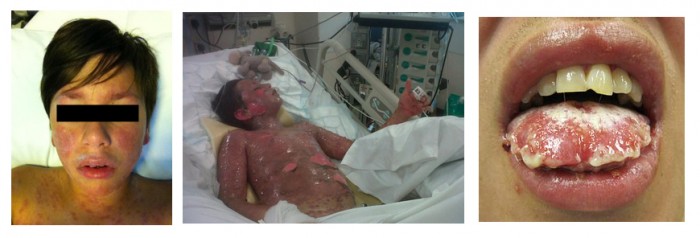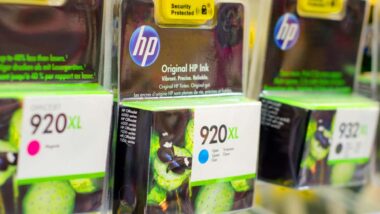Top Class Actions’s website and social media posts use affiliate links. If you make a purchase using such links, we may receive a commission, but it will not result in any additional charges to you. Please review our Affiliate Link Disclosure for more information.

Stevens Johnson Syndrome is marked by flu-like symptoms that ultimately produce a potentially life-threatening rash that can develop into a burn, open sores and skin peeling.
The two drugs most associated with skin reactions, including SJS and TEN, are Lamictal and Chantix, according to a report issued by the Institute for Safe Medication Practices (ISMP). The ISMP found that in 2012 alone the FDA received more than 200 reports of Lamictal SJS and Chantix SJS, including seven deaths.
Lamictal Stevens Johnson Syndrome
Lamictil is an anti-seizure medication used to treat epilepsy, seizures and Lennox-Gastaut syndrome (a severe form of epilepsy whose onset is typically before age four). It has also been approved since 2003 to treat Bipolar I disorder, characterized by severe mood episodes ranging from mania to depression.
Common side effects of Lamictil include dizziness, insomnia, nausea and vivid dreams.
Lamictil, which has been on the market for 20 years, has been linked to more cases of Stevens Johnson Syndrome and Toxic Epidermal Necrolysis than any other drug available between 1968 and 2009. Someone taking Lamictil has a 14-times greater likelihood of getting one of those diseases, at least one study has found.
Of the 200 reports of “severe cutaneous adverse reactions” (a category that encompasses scores of skin reactions), 119 of them involved Lamictil. Eighty-six of those reports were linked directly to SJS and TEN.
Lamictil’s SJS symptoms have been reported as a purplish rash that spreads, turning into painful blisters of the mucus membranes such as in the eyes, nose, mouth, and genitals. The SJS rash eventually causes the skin to slough off in large patches, causing joint and muscle pain and a burning sensation all over the body.
The onset of SJS symptoms can occur immediately or take years to manifest, the latter being common in adults who take Lamictil to treat bipolar disorder.
Chantix Stevens Johnson Syndrome
There were 93 cases of severe cutaneous events reported by users of Chantix, a smoking cessation medication. Two of the 93 were deaths in 2011, and five were directly linked to SJS or TEN, but many of the reports were consistent with those diseases. Twenty-eight Chantix users reported skin coming off their bodies and in excess of 50 percent complained of severe blisters.
Results of a study published in the journal Pediatrics showed that Lamictil poses a risk for SJS and TEN, a more severe form of SJS that also known as Lyell’s syndrome. With TEN, the top layer of skin (the epidermis) detached from the body, especially the mucous membranes, such as the mouth, eyes, and vagina.
Up to 40 percent of people who suffer TEN die from complications associated with the painful disease, compared with five to 15 percent of those with SJS. Survivors may experience lifelong health problems such as a secondary skin infection (cellulitis), sepsis (a blood infection), blindness, internal organ damage and permanent skin damage.
SJS Lawsuits Want Drug Makers Accountable
Hundreds of product liability lawsuits have been filed against drug makers for failing to disclose the risk of getting Stevens Johnson Syndrome or Toxic Epidermal Necrolysis from medication side effects.
Some juries have awarded millions of dollars in compensation to SJS victims and their families.
In general, SJS lawsuits are filed individually by each plaintiff and are not class actions.
Do YOU have a legal claim? Fill out the form on this page now for a free, immediate, and confidential case evaluation. The attorneys who work with Top Class Actions will contact you if you qualify to let you know if an individual lawsuit or class action lawsuit is best for you. Hurry — statutes of limitations may apply.
ATTORNEY ADVERTISING
Top Class Actions is a Proud Member of the American Bar Association
LEGAL INFORMATION IS NOT LEGAL ADVICE
Top Class Actions Legal Statement
©2008 – 2024 Top Class Actions® LLC
Various Trademarks held by their respective owners
This website is not intended for viewing or usage by European Union citizens.
Get Help – It’s Free
Help for Victims of Stevens Johnson Syndrome
If you or a loved one were diagnosed with Stevens Johnson Syndrome (SJS) or toxic epidermal necrolysis (TEN) after taking a prescribed or over-the-counter medication, you may be eligible to take legal action against the drug’s manufacturer. Filing an SJS lawsuit or class action lawsuit may help you obtain compensation for medical bills, pain and suffering, and other damages. Obtain a free and confidential review of your case by filling out the form below.
An attorney will contact you if you qualify to discuss the details of your potential case at no charge to you.
Oops! We could not locate your form.












